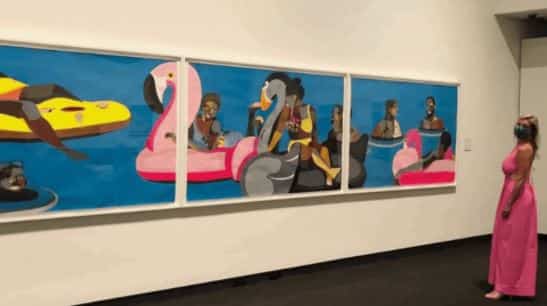Create
Hello goodbye: This week’s changing art exhibitions

The talk of the Tampa Bay art community this week is the Van Gogh Alive exhibit at the Dali Museum; judging by social media comments and reviews, hundreds (well, let’s say many dozens) have taken the immersive post-impressionist trip since the “show” opened to the public Nov. 21.
Two things to remember: Because visitors are closed into one big room for 40 minutes, advance tickets are required (get them here). And the next available day is Tuesday, Dec. 1.
Van Gogh Alive is a walk-through, always-moving study of the life and work of Vincent Van Gogh, using timed laser projectors and a stirring classical score. Here’s our extensive preview from last week.
Sunday is the last day to see two extraordinary exhibits at the Museum of Fine Arts St. Petersburg. Buoyant, a series of bright canvases by Derrick Adams, was the first new MFA show of the year – it opened in September, as did the truly fascinating Copper, Silver, Salt, Ink: The Chemistry of Photography’s Enduring Desires, a study of early photographic techniques.
After Sunday, they’re both outta here.
Color Riot! How Color Changed Navajo Textiles opens Dec. 19.
The recent renovations and upgrades to the MFA collection galleries were extensive, and really shine a light on some of the treasures in the permanent collection. Read more here.
Across the bay
 Although you wouldn’t know it from the complete lack of signage outside, the Tampa Museum of Art is exhibiting 100 paintings from the Highwaymen, the loose aggregate of mostly self-taught African American painters from the St. Lucie County area.
Although you wouldn’t know it from the complete lack of signage outside, the Tampa Museum of Art is exhibiting 100 paintings from the Highwaymen, the loose aggregate of mostly self-taught African American painters from the St. Lucie County area.
Living Color brings together original upson board (as opposed to canvas) paintings from the most significant of the landscape artists, notably Alfred Hair (1941-1971) and Harold Newton (1934-1994). The name Highwaymen refers to the original purpose of the artwork – it was sold door-to-door, up and down the highways on South Florida, in the 1950s and ‘60s.
Creating these deceptively simple landscapes was a way of making a free and independent dollar in those Jim Crow days.
 With their fluorescent colors and dreamlike clouds, the paintings are spectacular; seeing them up close, each brush stroke takes on depth, and it becomes apparent that these artists were masterful at applying colors in small amounts to create the illusion of form.
With their fluorescent colors and dreamlike clouds, the paintings are spectacular; seeing them up close, each brush stroke takes on depth, and it becomes apparent that these artists were masterful at applying colors in small amounts to create the illusion of form.
The Tampa exhibit was curated by Gary Monroe, author of the definitive book on the Highwaymen. In his book, and in his text for this show, he points out that Hair, Newton and the other artists were more interested in making sales than creating timeless imagery.
Of Hair, he writes: “He would tack up 20 boards at a time outdoors, then quickly lay down the color without sketches, as fast as he could, going from board to board, painting parts of sky, a tree or some other element. The essence of his paintings was spontaneity, bold colors, palm trees, surf, sand and incredible skies.
“Painting fast was a prerequisite, not a deterrent to Hair’s art. He simply ‘threw paint’ on his boards to miraculously achieve images that are more about being alive than about the manipulation of plastic values.”
Living Color: The Art of the Highwaymen is on view through March 28.








